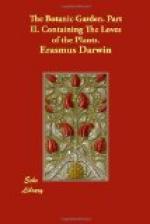XXI. ONE HOUSE, Monoecia. Male flowers and female flowers separate, but on the same plant.
XXII. TWO HOUSES, Dioecia. Male flowers and female flowers separate, on different plants.
XXIII. POLYGAMY, Polygamia. Male and female flowers on one or more plants, which have at the same time flowers of both sexes.
The last Class contains the plants whose flowers are not discernible.
XXIV. CLANDESTINE MARRIAGE, Cryptogamia.
The Orders of the first thirteen Classes are founded on the number of Females, or Pistils, and distinguished by the names, ONE FEMALE, Monogynia. TWO FEMALES, Digynia. THREE FEMALES, Trigynia, &c. as is seen in No. i. which represents a plant of one male, one female; and in the first Figure of No. xi. which represents a flower with twelve males, and three females; (for, where the pistils have no apparent styles, the summits, or stigmas, are to be numbered) and in the first Figure of No. xii. which represents a flower with twenty males and many females; and in the last Figure of the same No. which has twenty males and one female; and in No. xiii. which represents a flower with many males and many females.
The Class of TWO POWERS, is divided into two natural Orders; into such as have their seeds naked at the bottom of the calyx, or flower cup; and such as have their seeds covered; as is seen in No. xiv. Fig. 3. and 5.
The Class of FOUR POWERS, is divided also into two Orders; in one of these the seeds are inclosed in a silicule, as in Shepherd’s purse. No. xiv. Fig. 5. In the other they are inclosed in a silique, as in Wall-flower. Fig. 4.
In all the other Classes, excepting the Classes Confederate Males, and Clandestine Marriage, as the character of each Class is distinguished by the situations of the males; the character of the Orders is marked by the numbers of them. In the Class ONE BROTHERHOOD, No. xvi. Fig. 3. the Order of ten males is represented. And in the Class TWO BROTHERHOODS, No. xvii. Fig. 2. the Order ten males is represented.
In the Class CONFEDERATE MALES, the Orders are chiefly distinguished by the fertility or barrenness of the florets of the disk, or ray of the compound flower.
And in the Class of CLANDESTINE MARRIAGE, the four Orders are termed FERNS, MOSSES, FLAGS, and FUNGUSSES.
The Orders are again divided into Genera, or Families, which are all natural associations, and are described from the general resemblances of the parts of fructification, in respect to their number, form, situation, and reciprocal proportion. These are the Calyx, or Flower-cup, as seen in No. iv. Fig. 1. No. x. Fig. 1. and 3. No. xiv. Fig. 1. 2. 3. 4. Second, the Corol, or Blossom, as seen in No. i. ii. &c. Third, the Males, or Stamens; as in No. iv. Fig. 1. and No. viii. Fig. 1. Fourth, the Females, or Pistils; as in No. i. No. xii. Fig. 1. No. xiv. Fig. 3. No. xv. Fig. 3. Fifth, the Pericarp or Fruit-vessel; as No. xv. Fig. 4. 5. No. xvii. Fig. 2. Sixth, the Seeds.




